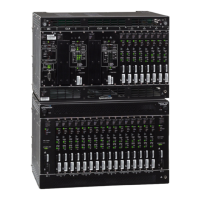1
097-55501-01 Issue 6 – June 2003 33
2
5
3
Description
1.3.7.2 Contact Closure Outputs
Contact closure outputs are provided to actuate visible and/or audible
alarm indicators to inform the office of an alarm condition within the shelf.
1.3.8 Output Driver Cards
Output driver cards provide non-protected or protected DS1 or CC outputs.
A single output driver card provides 40 non-protected outputs. Two output
driver cards functioning as a pair provide 40 protected outputs. A single
output driver card can provide 20 DS1 and 20 CC outputs or 40 of either
type. There can be up to 140 outputs per shelf, with a combination of DS1
and CC outputs.
1.3.8.1 Output Port Alarms in TimeHub 5500
The TimeHub output cards contain a sensing circuit whose purpose is to
detect output signal failures. There is such a circuit associated with every
output port. The intent of the sensing circuit is to detect and report on
internal component failures associated with the port output circuitry.
When a port alarm is detected on a given output card, there are several
responses:
• For output cards with FPGA version A, the Fail LED on the output
card will illuminate. For output cards with FPGA version B or later,
the Alarm LED on the output card will illuminate. (FPGA version
can be seen at the end of output card version information in RTRV-
NETYPE-ALL response).
• An OPPTFLXX (Output Port Fail) event is generated, where XX
identifies the specific port number.
• If both output port cards in a redundant pair have detected port
alarms on the same port, the OPTALMEXT (“Alarms on same ports
- check external conditions”) event will be generated. See detailed
description of this event in Table M of the TimeHub 5500 TL1
reference manual.
• If both output cards in a redundant pair have detected port alarms
but not on the same ports, the OPPRFL event is generated. See
detailed description in Table M of the TimeHub 5500 TL1 reference
manual.
N
OTE
: Contact closure outputs are generated by the
management card. The management card is required in order
to generate contact closure alarms or TL1 messages.

